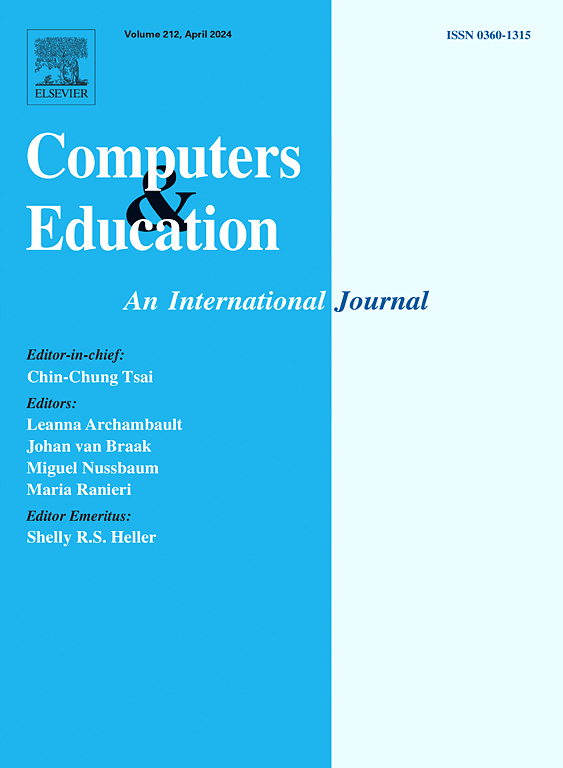Measuring teacher scaffolding in game-based learning: Emotional and responsibility scaffolds lead while resources and previous game experience shape practices
IF 10.5
1区 教育学
Q1 COMPUTER SCIENCE, INTERDISCIPLINARY APPLICATIONS
引用次数: 0
Abstract
Previous research shows that teacher characteristics, such as gender and teaching experience, and affective factors, including attitudes and beliefs, influence the integration of games into classrooms. However, there is little understanding of how teachers provide scaffolding to support students' learning during gameplay and address diverse learning needs. Thus, this study aimed to 1) develop and validate a Teacher Scaffolding Questionnaire for Game-Based Learning (TSQ-GBL), 2) identify the types of scaffolds teachers use most frequently, and 3) examine how the perceived availability of school resources and prior use of game-based pedagogies influence teachers' scaffolding practices. A cross-sectional sample of 180 K-12 in-service teachers participated to validate the instrument, assess scaffolding use, and analyze the relationships between variables. A confirmatory factor analysis validated a three-dimensional model of scaffolding, involving cognitive, responsibility, and emotional scaffolds. Teachers reported greater use of responsibility and emotional scaffolds compared to cognitive scaffolds. Path analysis showed that prior use of game-based pedagogies directly increased scaffold use, while the perceived availability of school resources indirectly influenced scaffolding practices. These findings emphasize the need to increase resource availability and teachers’ prior pedagogical experience with games to strengthen scaffolding practices during game-based learning. This study contributes to theoretical advancements by providing a validated instrument and uncovering the relationships between teacher scaffolding practices, the availability of school resources, and prior game-based pedagogy experiences, ultimately supporting the effective integration of games in education.
在基于游戏的学习中测量教师脚手架:情感和责任脚手架起主导作用,而资源和以前的游戏经验则形成实践
先前的研究表明,教师的特征(如性别和教学经验)和情感因素(包括态度和信念)会影响游戏融入课堂。然而,对于教师如何提供脚手架来支持学生在游戏过程中的学习和满足不同的学习需求,我们却知之甚少。因此,本研究的目的是:1)开发并验证教师基于游戏学习的脚手架问卷(TSQ-GBL), 2)确定教师最常使用的脚手架类型,以及3)检查学校资源的感知可用性和游戏教学法的先前使用如何影响教师的脚手架实践。通过对180名K-12在职教师的横断面抽样来验证该工具,评估脚手架的使用情况,并分析变量之间的关系。验证性因子分析验证了一个三维支架模型,包括认知、责任和情感支架。与认知支架相比,教师报告更多地使用责任和情感支架。通径分析显示,先前使用基于游戏的教学法直接增加了脚手架的使用,而学校资源的可获得性间接影响了脚手架的使用。这些发现强调需要增加资源的可用性和教师先前的游戏教学经验,以加强基于游戏的学习过程中的脚手架实践。本研究提供了一种有效的工具,揭示了教师脚手架实践、学校资源的可用性和先前基于游戏的教学经验之间的关系,从而有助于理论的进步,最终支持游戏在教育中的有效整合。
本文章由计算机程序翻译,如有差异,请以英文原文为准。
求助全文
约1分钟内获得全文
求助全文
来源期刊

Computers & Education
工程技术-计算机:跨学科应用
CiteScore
27.10
自引率
5.80%
发文量
204
审稿时长
42 days
期刊介绍:
Computers & Education seeks to advance understanding of how digital technology can improve education by publishing high-quality research that expands both theory and practice. The journal welcomes research papers exploring the pedagogical applications of digital technology, with a focus broad enough to appeal to the wider education community.
 求助内容:
求助内容: 应助结果提醒方式:
应助结果提醒方式:


